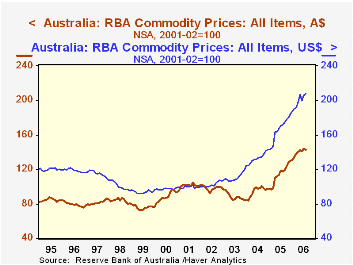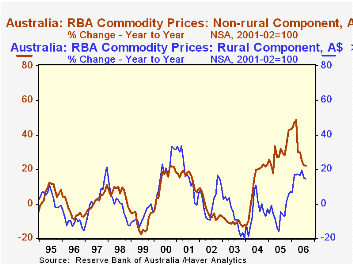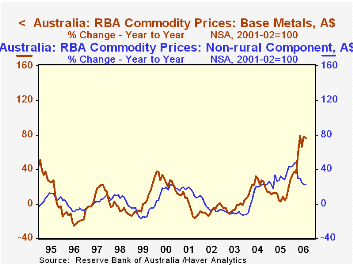 Global| Sep 01 2006
Global| Sep 01 2006Commodity Prices Moderate in Australia After Explosion in Metals Sector
Summary
The Reserve Bank of Australia reported today its commodity price index for August. The overall index fell 0.8% from July in Australian dollar terms and rose 0.7% in US dollars. From a year ago, the A$ total is up 20.7%, and 20.8% in [...]

The Reserve Bank of Australia reported today its commodity price index for August. The overall index fell 0.8% from July in Australian dollar terms and rose 0.7% in US dollars. From a year ago, the A$ total is up 20.7%, and 20.8% in US$.
Within the Aussie dollar measure, agricultural, or "rural" commodities, fell 3.4% in August but are 14.5% ahead of August 2005. Generally, those items, which include a variety of farm products such as beef, wheat and cotton, have been falling over the last three years. Non-farm products, however, have had strong prices, with gains of nearly 23% in 2004 and 43% in 2005; the August figure is showing signs of slowing, with a decline from July of 0.1%, helping to bring the year-on-year figure down to 22.2%.
However, within the non-farm category metals prices have risen even more substantially in most of the last several months. The recent boom in metals prices is worldwide, and Australia has participated. In August, so-called "base metals" were up 2.2%, following 7.1% in July. June's prices fell, but that came after double-digit leaps in each April and May that totaled 27.8%. This component is up a whopping 76.2% from August 2005. The items in this index are copper, aluminum, nickel, zinc and lead.
Most central banks don't calculate their own price indexes. Statistics bureaus tend to do that or, often for commodities, private market sources do it. We were aware that commodities are important to the Australian economy, and in browsing the Reserve Bank's website, we learned that exports constitute about 20% of that nation's national income and that "primary commodities" are a sizable portion of exports. So the central bank's interest in these raw materials prices is substantive regarding their effect on inflation, terms of trade and the health of the real economy. Exchange rate differentials are seen to have a quite noticeable impact on the movement of the price index, particularly with many of these items priced in US$ in world markets.
| Australia | Aug 2006 | July 2006 | June 2006 | Aug 2005 | 2005 | 2004 | 2003 |
|---|---|---|---|---|---|---|---|
| Commodity Price Index, A$ | 142.5 | 143.6 | 141.0 | 118.1 | 113.8 | 94.4 | 88.8 |
| % Change | -0.8 | 1.8 | -0.7 | 20.7 | 20.6 | 6.3 | -9.8 |
| Commodity Price Index, US$ | 207.7 | 206.2 | 199.5 | 171.9 | 165.6 | 132.6 | 110.3 |
| % Change | 0.7 | 3.4 | -3.7 | 20.8 | 24.8 | 20.2 | 7.9 |
| Rural Commodities, A$ | 96.5 | 99.9 | 98.4 | 84.3 | 87.0 | 91.4 | 96.1 |
| % Change | -3.4 | 1.5 | 0.8 | 14.5 | -4.9 | -4.8 | -7.5 |
| Non-Rural Commodities, A$ | 161.3 | 161.5 | 158.5 | 132.0 | 124.8 | 95.6 | 85.8 |
| % Change | -0.1 | 1.9 | -1.1 | 22.2 | 30.5 | 11.4 | -10.7 |
| Of which: Base Metals, A$ | 219.5 | 214.8 | 200.6 | 124.6 | 125.3 | 122.7 | 93.8 |
| % Change | 2.2 | 7.1 | -6.9 | 76.2 | 11.2 | 20.1 | -4.6 |
Carol Stone, CBE
AuthorMore in Author Profile »Carol Stone, CBE came to Haver Analytics in 2003 following more than 35 years as a financial market economist at major Wall Street financial institutions, most especially Merrill Lynch and Nomura Securities. She had broad experience in analysis and forecasting of flow-of-funds accounts, the federal budget and Federal Reserve operations. At Nomura Securities, among other duties, she developed various indicator forecasting tools and edited a daily global publication produced in London and New York for readers in Tokyo. At Haver Analytics, Carol was a member of the Research Department, aiding database managers with research and documentation efforts, as well as posting commentary on select economic reports. In addition, she conducted Ways-of-the-World, a blog on economic issues for an Episcopal-Church-affiliated website, The Geranium Farm. During her career, Carol served as an officer of the Money Marketeers and the Downtown Economists Club. She had a PhD from NYU's Stern School of Business. She lived in Brooklyn, New York, and had a weekend home on Long Island.





